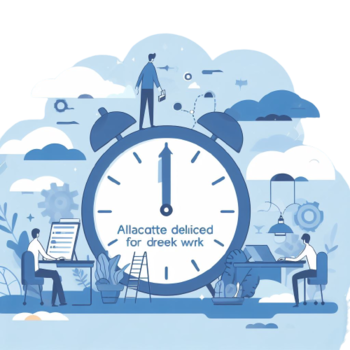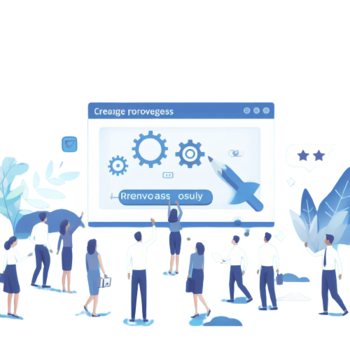Rhythmic Philosophy of Deep Work Scheduling
Transitioning to a state of deep work might seem daunting, especially with a pile of everyday tasks at hand. That's where the Rhythmic Philosophy of deep work scheduling comes into play. This approach is about finding a daily rhythm to ease into deep work, making it a regular part of your routine.
1.Predictable Daily Structure: Anticipating the structure of your day is crucial. Knowing when and where you'll have blocks of uninterrupted time allows for a systematic approach towards engaging in deep work.
2. Daily Deep Work Blocks: Allocate specific hours each day exclusively for deep work. This scheduled approach ensures that despite the hustle and bustle of daily tasks, you still have a dedicated slot for focused work.
3. Balance with Shallow Work: The rhythm of diving into deep work daily, while leaving the rest of your hours for shallow work, provides a balanced work structure. It's about harmonizing the urgent and the important to ensure neither gets neglected.
4. Journalistic Philosophy of Deep Work Scheduling : For individuals with erratic schedules or those constantly on the move, finding a regular slot for deep work might seem impossible. The Journalistic Philosophy of deep work scheduling provides a solution.
5. Adaptability: This method is about adapting to the day's flow and finding pockets of time to engage in deep work. It requires a keen sense of awareness to notice natural pauses in your day that can be utilized for focused work.
6. Utilizing Available Slots: Whether it's a free half-hour or a couple of hours, the journalistic approach allows you to slot in deep work sessions whenever possible. This flexibility ensures that despite a hectic schedule, deep work isn't sidelined.
7. Not for Novices: However, this method demands a certain level of expertise in managing one's time and being able to switch to a deep work mode on a whim. It's not recommended for beginners, as it's likely to fail for those not experienced in deep work.
8. Building a Robust Deep Work Routine : To truly harness the power of deep work, establishing a routine that facilitates this profound level of focus is imperative. Here are steps and considerations to help you build a robust deep work routine.
9. Craft a Conducive Environment: Begin by selecting a space that’s devoid of distractions, setting the stage for extended periods of focus. In case a quiet location is unavailable, noise-canceling headphones can be a lifesaver, creating a bubble of concentration amidst chaos.
10. Signal Your Brain: Develop cues that signal your brain it’s time to delve into deep work. Being consistent with your environment, like working at the same spot or listening to a particular genre of music, can create a familiarity that hastens the transition into deep work mode.
11. Allocate Time Judiciously: Before initiating a deep work session, decide the amount of time you'll dedicate to the task at hand. Starting small, say 15 minutes, and gradually extending these sessions can be a pragmatic approach.
12. Exercise Your Focus Muscle: As you increase the length of your deep work sessions, you’ll notice an improvement in your ability to maintain focus. It’s akin to flexing a muscle; the more you exercise it, the stronger it becomes.
13. Establish a Structure:Define what your deep work mode entails. For instance: Will your phone be switched off or on silent? Is checking the internet allowed? Can you take short breaks for a snack or a walk? How will you gauge the success of a session—through pages read, lines of code written, or words penned down?
14. Evaluate and Adapt: After a few sessions, evaluate what aids your deep work routine. It might be a specific type of music, your favorite beverage, or access to certain software. Tailoring your environment to suit your deep work routine further is an ongoing process that enhances your ability to engage in focused work.
"Start Your Deep Work Journey Now! Unleash Your Productivity!"
Executing a Grand Gesture: Amplifying the Importance of Deep Work
Sometimes, the routine attempts at engaging in deep work may fall short, especially when the goals are lofty or the motivation is dwindling. This calls for an unconventional approach known as executing a grand gesture. This tactic involves making a significant change to your regular environment or routine, sometimes coupled with a substantial investment of effort or resources, all aimed at bolstering the deep work ethos.

1. Inducing a Radical Change
The essence of a grand gesture lies in inducing a radical change that elevates the perceived importance of the task at hand. For instance, if you find the usual office setting stifling for a critical project, negotiate with your manager to work from home for a week to get it done.

2. Allocating Dedicated Time
Instead of nibbling at a task in small increments, dedicate an entire day or more to immerse yourself in it. For example, spending a day writing in a library as opposed to chipping away at your paper in 20-minute increments at home could be a radical shift that propels you into a deep work state.

3.Embracing Novelty
The concept of a grand gesture is rooted in harnessing the power of novelty to alert your mind about the significance of a task. A change in your regular routine can trigger a mental shift, facilitating a deeper level of focus and engagement.

4. Learn from the Masters
Take a leaf out of Bill Gates' book, who engages in a “think week” twice a year. He retreats to his cottage for two weeks, dedicating this time solely to reading and contemplating the future of Microsoft. This grand gesture epitomizes how a significant shift from the norm can foster a conducive environment for deep work.

5. Investing in the Task
Sometimes, a financial or effort-based investment in the task can also serve as a grand gesture. It signifies the importance you attribute to the task, thereby psychologically preparing you to engage in deep work.
Fostering Collaboration Within a Deep Work Framework
The emphasis on deep work often heralds an image of solitary endeavor. While deep work indeed thrives in solitude, this doesn't spell the demise of collaborative efforts. Collaborating with others can spark a realm of "serendipitous creativity" that we might not stumble upon in isolation. The key lies in striking a harmonious balance between deep work and collaborative engagements.
1. Harnessing Collective Brilliance: Working with others can provide fresh perspectives and insights that could be the catalyst for groundbreaking ideas. This collaborative venture can propel the project forward in ways that might not have been possible solo.
2. Segregating Solo and Collaborative Efforts:The trick is to keep deep work and collaborative sessions distinct. Trying to meld the two, as seen in open-floor office designs, often leads to distractions rather than fruitful interactions. Dedicate specific times for solo deep work and others for collaborative endeavors.
3. Enhancing Learning Through Interaction: Engaging with others can be a learning experience. The knowledge and insights garnered from collaborative sessions can later be delved into more deeply during your solo deep work periods.
4. Collaborative Deep Work: There are instances where deep work can be collaborative. When working together on a complex problem with a shared objective, the mutual focus and complementary skills can drive both the project and each other towards exemplary outputs.
5. Employer's Role: Employers should recognize the importance of both solo deep work and collaborative sessions. Structuring the work environment to facilitate both, perhaps by providing quiet spaces for deep work and common areas for collaboration, can significantly enhance productivity and innovation.
6. Regular Collaborative Engagements: Collaboration should not be an occasional endeavor but a regular feature. It's a potent tool that, when utilized wisely, can lead to enhanced problem-solving, innovative solutions, and a more enriching work experience.


.png)


